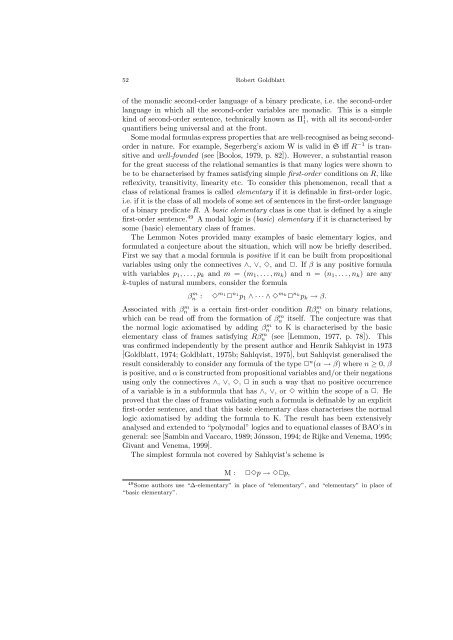MATHEMATICAL MODAL LOGIC: A VIEW OF ITS EVOLUTION
MATHEMATICAL MODAL LOGIC: A VIEW OF ITS EVOLUTION
MATHEMATICAL MODAL LOGIC: A VIEW OF ITS EVOLUTION
You also want an ePaper? Increase the reach of your titles
YUMPU automatically turns print PDFs into web optimized ePapers that Google loves.
52 Robert Goldblattof the monadic second-order language of a binary predicate, i.e. the second-orderlanguage in which all the second-order variables are monadic. This is a simplekind of second-order sentence, technically known as Π 1 1, with all its second-orderquantifiers being universal and at the front.Some modal formulas express properties that are well-recognised as being secondorderin nature. For example, Segerberg’s axiom W is valid in S iff R −1 is transitiveand well-founded (see [Boolos, 1979, p. 82]). However, a substantial reasonfor the great success of the relational semantics is that many logics were shown tobe to be characterised by frames satisfying simple first-order conditions on R, likereflexivity, transitivity, linearity etc. To consider this phenomenon, recall that aclass of relational frames is called elementary if it is definable in first-order logic,i.e. if it is the class of all models of some set of sentences in the first-order languageof a binary predicate R. A basic elementary class is one that is defined by a singlefirst-order sentence. 49 A modal logic is (basic) elementary if it is characterised bysome (basic) elementary class of frames.The Lemmon Notes provided many examples of basic elementary logics, andformulated a conjecture about the situation, which will now be briefly described.First we say that a modal formula is positive if it can be built from propositionalvariables using only the connectives ∧, ∨, ✸, and ✷. If β is any positive formulawith variables p 1 , . . . , p k and m = (m 1 , . . . , m k ) and n = (n 1 , . . . , n k ) are anyk-tuples of natural numbers, consider the formulaβ m n : ✸ m1 ✷ n1 p 1 ∧ · · · ∧ ✸ m k✷ n kp k → β.Associated with βn m is a certain first-order condition Rβn m on binary relations,which can be read off from the formation of βnm itself. The conjecture was thatthe normal logic axiomatised by adding βnm to K is characterised by the basicelementary class of frames satisfying Rβn m (see [Lemmon, 1977, p. 78]). Thiswas confirmed independently by the present author and Henrik Sahlqvist in 1973[Goldblatt, 1974; Goldblatt, 1975b; Sahlqvist, 1975], but Sahlqvist generalised theresult considerably to consider any formula of the type ✷ n (α → β) where n ≥ 0, βis positive, and α is constructed from propositional variables and/or their negationsusing only the connectives ∧, ∨, ✸, ✷ in such a way that no positive occurrenceof a variable is in a subformula that has ∧, ∨, or ✸ within the scope of a ✷. Heproved that the class of frames validating such a formula is definable by an explicitfirst-order sentence, and that this basic elementary class characterises the normallogic axiomatised by adding the formula to K. The result has been extensivelyanalysed and extended to “polymodal” logics and to equational classes of BAO’s ingeneral: see [Sambin and Vaccaro, 1989; Jónsson, 1994; de Rijke and Venema, 1995;Givant and Venema, 1999].The simplest formula not covered by Sahlqvist’s scheme isM :✷✸p → ✸✷p,49 Some authors use “∆-elementary” in place of “elementary”, and “elementary” in place of“basic elementary”.
















